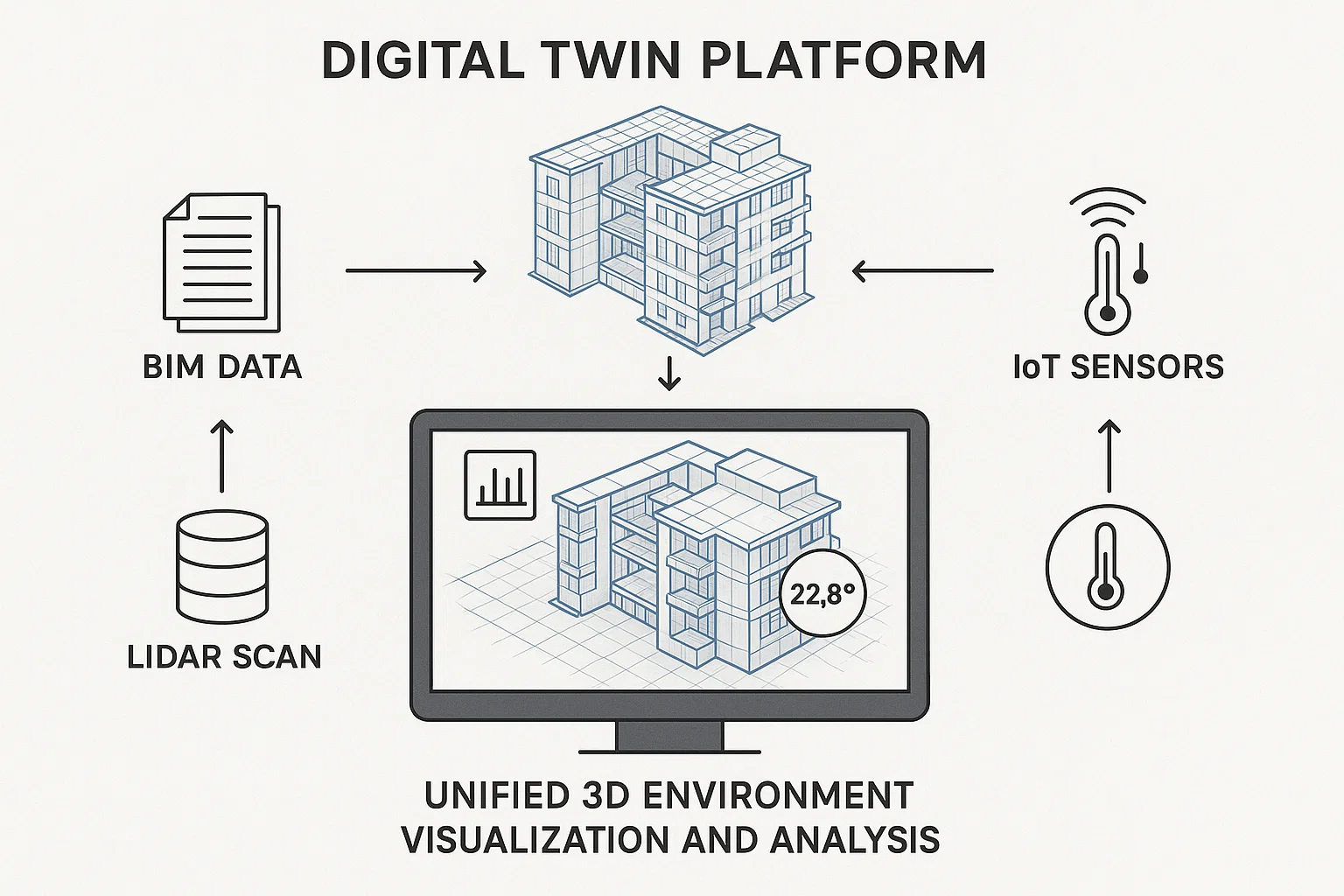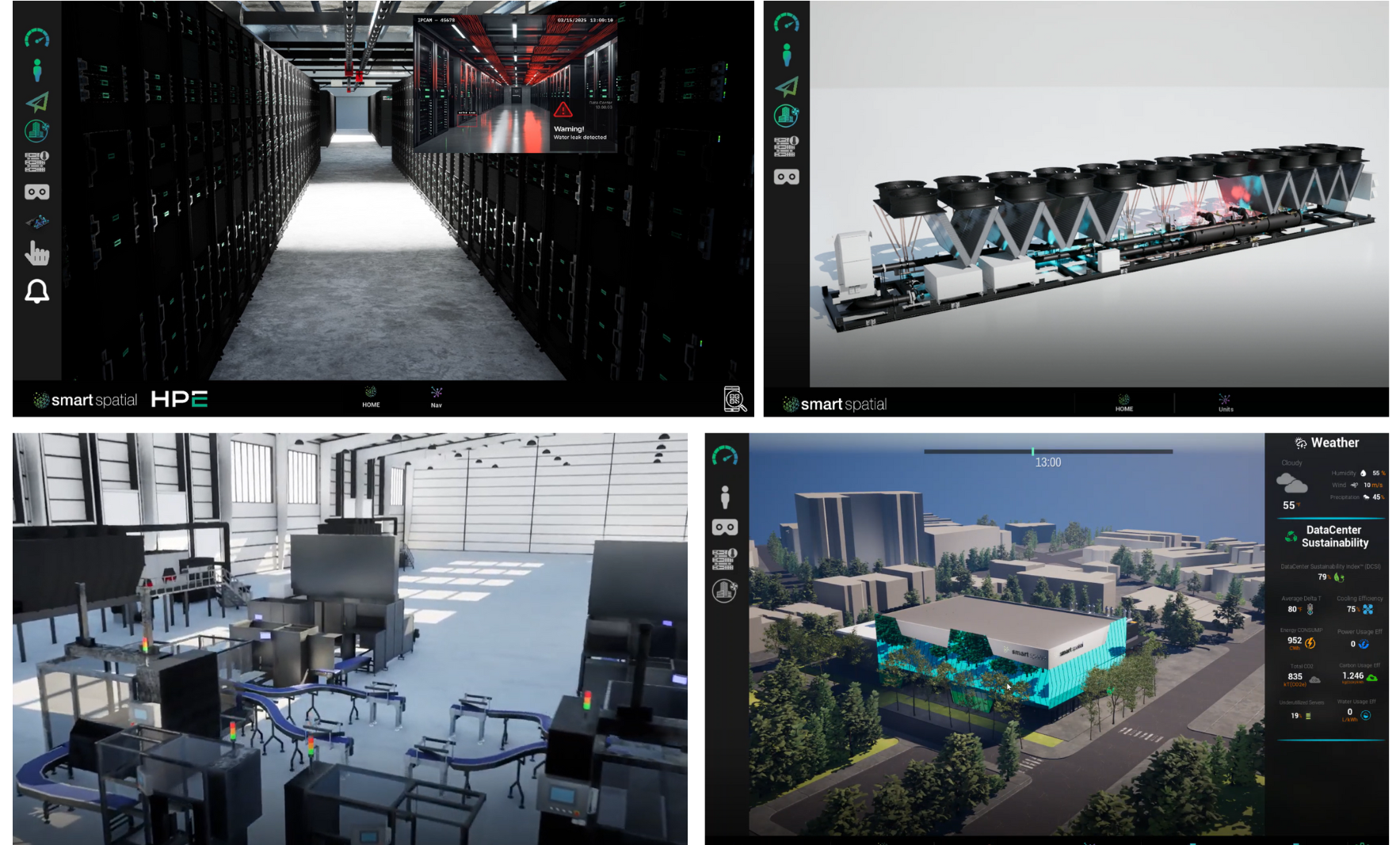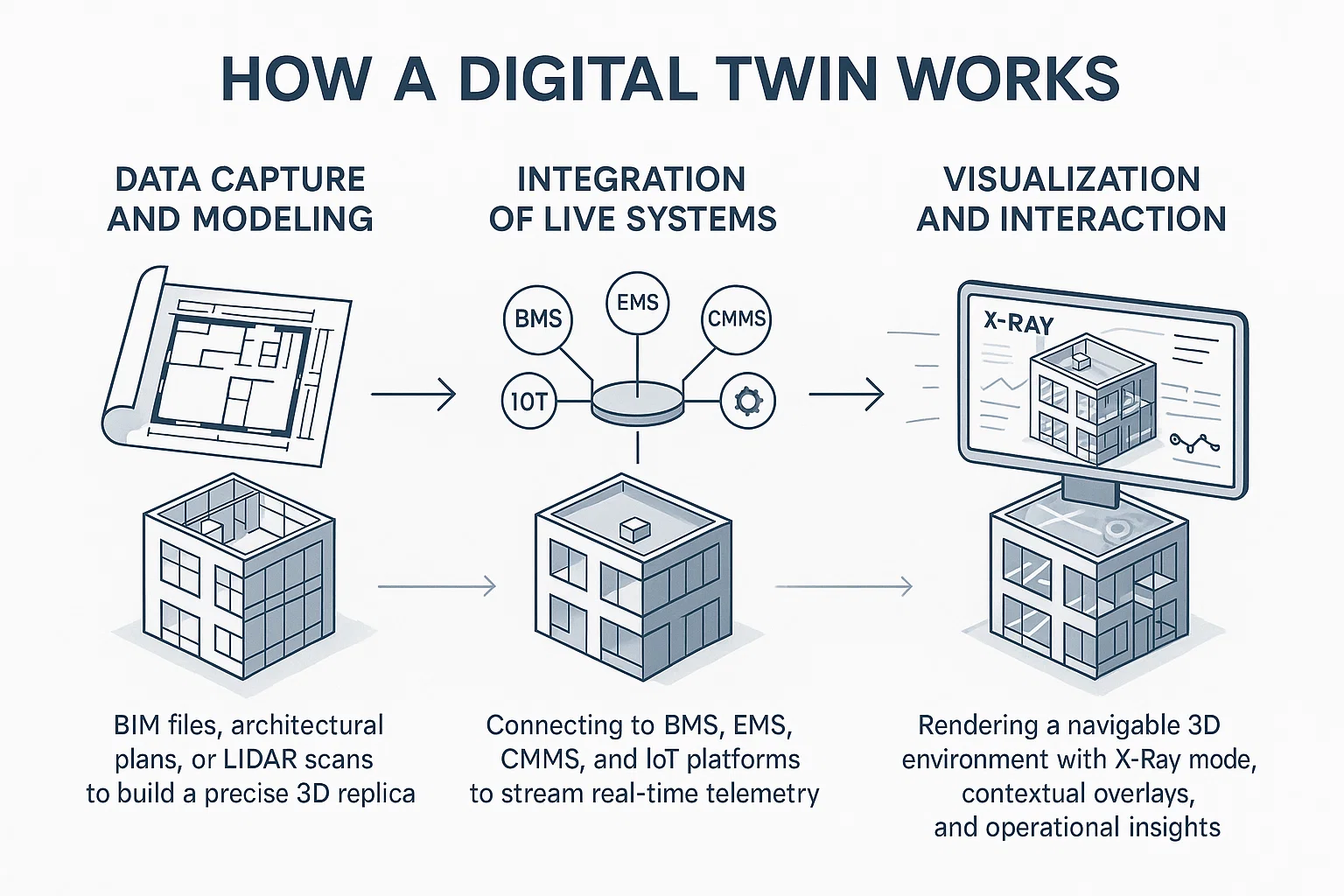Table of Contents
1. Introduction
2. Understanding Digital Twins
3. Real-World Digital Twin Examples
4. How a Digital Twin Works
5. Uses and Business Value
6. Digital Twin Software and Implementation
7. Strategic Benefits Across Industries
8. Conclusion
9. FAQ
What is a digital twin example? At its core, it is a virtual, data-driven replica of a physical asset, environment, or process. By integrating real-time information from connected systems, a digital twin mirrors and enhances how an asset operates. Smart Spatial applies this concept to create operational digital twins for complex facilities — from data centers and airports to commercial real estate and manufacturing plants.
By combining high-fidelity 3D visuals with live data from operational systems, Smart Spatial gives teams the tools to make better decisions, run assets more efficiently, and keep them in service longer. These realistic digital environments change how people see and work with their facilities, making day-to-day management and long-term planning part of a single, connected process.
Understanding Digital Twins
A digital twin goes beyond a static 3D model. It is an interactive environment that shows what is happening with a physical asset at any given moment. Instead of depending on fixed 2D diagrams, it brings together spatial data, sensor readings, and operational system inputs in one place.
Smart Spatial builds these environments by combining architectural plans, BIM models, LiDAR scans, and live telemetry with advanced rendering engines such as Unity, Unreal, and NVIDIA Omniverse. This integration creates highly accurate, navigable 3D environments accessible across desktop, mobile, and VR devices.
The advantage over conventional modeling is clear:
- Contextual awareness — X-Ray vision and component-level details provide insights that 2D cannot.
- Interactivity — Users can navigate with fly or walk modes, switch to predefined views, and examine any element in detail.
- Live synchronization — Data from Building Management Systems (BMS), Energy Management Systems (EMS), and other platforms updates the model in real time.
By merging visualization and operations, a digital twin becomes a single source of truth. It offers the ability to replay past events, see how systems interact, and explore scenarios that would be impractical or impossible in the physical world. This shift moves digital twins from being a static planning tool to becoming an operational command center.

Real-World Digital Twin Examples
Digital twin examples exist across multiple industries, each delivering measurable value:
- Airports and transportation hubs use operational digital twins to monitor terminal systems from a unified 3D interface instead of dozens of separate 2D dashboards. This consolidated view improves situational awareness and speeds decision-making.
- Data centers leverage twins to visualize Tier-level infrastructure differences, integrate live performance metrics, and run failure simulations for training and risk prevention.
- Corporate real estate benefits from virtual tours during design and construction, enabling remote collaboration with stakeholders who can explore layouts, systems, and finishes from anywhere.
- Industrial facilities apply twins to map and monitor equipment, track energy flows, and predict maintenance needs.

Each implementation starts with high-fidelity 3D capture and evolves into an operational platform. Examples include Kevlinx’s BRU01 Digital Twin in Brussels, which provides true-to-life facility access during construction, showcasing engineering quality and sustainability focus.
By demonstrating capabilities in real environments, these twins show that they are not theoretical models but practical tools driving operational and strategic improvements.
How a Digital Twin Works
An operational digital twin works through three main stages:
- Data capture and modeling — Using BIM files, architectural plans, or LiDAR scans, Smart Spatial creates a precise digital replica of the asset.
- Integration of live systems — The twin connects to operational platforms such as BMS, EMS, CMMS, and analytics tools. This allows it to ingest telemetry from sensors and equipment in real time.
- Visualization and interaction — The 3D environment is rendered with full navigation capabilities, X-Ray mode, and contextual overlays.

Once active, the twin continuously synchronizes with live data streams. Operators can:
- Monitor systems in a unified interface.
- Use “time machine” functions to replay events for analysis.
- Execute control actions directly through the twin, enabling two-way communication with connected systems.
With this setup, the twin is no longer just a visual model — it works as a central point for day-to-day operations. It can be expanded with tools like flow simulations for air, water, or power, detailed equipment views, and quick thematic filters, for example, showing only cable trays or firebreak walls. This makes it adaptable and able to grow as operational needs change.
Uses and Business Value
Digital twins offer significant business benefits:
- Operational efficiency — Reduce time spent switching between platforms with a single operational view.
- Predictive maintenance — Use analytical heat maps and historical data to schedule interventions before failures occur.
- Safety and compliance — Access manuals, logs, and component details directly in the 3D environment, improving maintenance accuracy.
In day-to-day operations, a twin can:
- Locate assets instantly in 3D space.
- Support remote troubleshooting to cut travel costs.
- Enable cross-department collaboration with shared visual context.
From a strategic perspective, operational digital twins contribute to sustainability by optimizing energy use and extending asset life. They also enhance customer engagement when applied in marketing and sales contexts, creating immersive product demos and virtual tours. In practice, this can mean faster incident response through unified alarms, improved onboarding with spatial context, and lower maintenance costs via proactive planning.
These advantages align with business goals across sectors, making digital twins a high-value investment in both operations and client engagement.
Digital Twin Software and Implementation
Smart Spatial’s deployment process follows a clear sequence:
- BIM/Scan to Twin (1–2 weeks) — Import and process BIM or LiDAR scan data into a high-fidelity 3D model.
- Data integration (1–3 months) — Connect operational systems and sensor networks to feed live data into the twin.
- Use-case enhancements — Add workflows such as training simulations, flow physics, or thematic views.
Throughout this process, the model is accessible on desktop, mobile, and VR, enabling immediate benefits:
- For sales and marketing: Guided and self-guided tours, interactive demos, and marketing content generation.
- For operations: Remote monitoring, maintenance planning, and incident replay.
- For training: Lifelike simulations, onboarding, and certification workflows.
This approach ensures advantages across multiple business functions. In sales and marketing, it enables guided and self-guided tours, interactive demos, and marketing content generation. For operations, it supports remote monitoring, maintenance planning, and incident replay. In training, it delivers lifelike simulations, onboarding, and certification workflows.
The implementation process typically follows five steps: capture and model the physical asset, integrate operational data streams, deploy multi-device access, add custom workflows and scenarios, and iterate with new use cases over time.
Strategic Benefits Across Industries
Digital twins deliver value across multiple sectors:
- Manufacturing — Model production environments, track asset performance, and simulate process changes for efficiency.
- Logistics — Map storage facilities and monitor inventory flows with real-time updates.
- Commercial real estate — Use high-fidelity twins to market spaces before construction is complete, reducing sales cycles.
- Critical infrastructure — Apply training scenarios for safety, from high-risk equipment operation to emergency drills.
These benefits are amplified when operational twins are integrated across business functions. For example, a facility model used for operations can also serve as a sales tool, training environment, and marketing asset, maximizing return on investment.
By enabling multi-purpose use from a single digital environment, Smart Spatial ensures that clients extract value across the entire asset lifecycle — from planning and construction to daily operations and stakeholder engagement.
Conclusion
Operational digital twins have moved beyond the conceptual stage into practical, high-impact tools for managing complex spaces. By combining high-fidelity visualization with live operational data, they offer a unified environment for monitoring, decision-making, and collaboration.
Smart Spatial’s track record — from high-security data centers to sprawling transport hubs — demonstrates how these solutions improve efficiency, safety, and sustainability. With deployment measured in weeks, not years, and scalability across devices and use cases, operational digital twins are redefining how organizations interact with their built environments.
To explore how these capabilities can enhance your operations, contact Smart Spatial for a demonstration and see firsthand how a digital twin example can transform your space into an intelligent, connected asset.
FAQ
Q1: What is a digital twin example?
It’s a virtual version of a real object, space, or process. For example, Smart Spatial builds twins of airports and office buildings so operators can watch systems in real time and plan maintenance before problems occur.
Q2: What is the use of a digital twin?
It helps run assets more efficiently, cut costs, and prevent downtime by simulating and tracking their performance while they’re in use.
Q3: How does a digital twin work?
Sensors and other systems feed live data into a 3D model. Analytical tools then turn that data into practical information for planning, maintenance, or operations.
Q4: What is the digital twin concept?
It’s the idea of making an accurate digital copy of a physical asset or environment so you can test changes, improve performance, and monitor it over time.
Q5: What is digital twin software?
Software that brings together 3D models, live sensor data, and analytics so teams can build, update, and manage digital versions of their assets.
Q6: How are digital twins implemented?
Spatial data is captured, a detailed model is created, and it is linked to live feeds from equipment and systems, and tied into the tools used for daily operations.
Q7: What does digital twin mean?
It’s a digital stand-in for a real asset, designed to reflect its condition and behaviour so you can analyse it, forecast changes, and make improvements.

